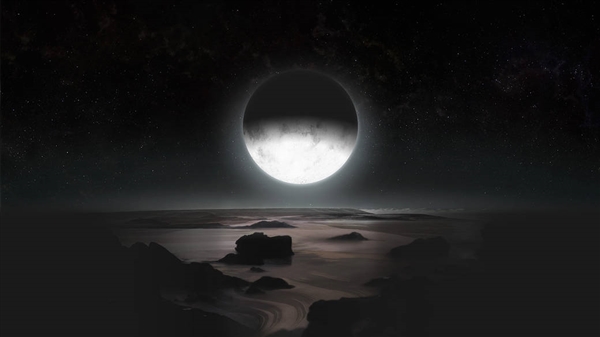So if Pluto really is a planet, it is certainly an odd one. It is very tiny: just one-quarter of 1 percent as massive as Earth. If you set it down on top of the United States, it would cover not quite half the lower forty-eight states.
因此,如果冥王星真是一颗行星,那肯定是一颗很怪的行星。它很小,只有地球的四百分之一大。假如你把它盖在美国上面,它还盖不住美国本土48州的一半面积。
This alone makes it extremely anomalous; it means that our planetary system consists of four rocky inner planets, four gassy outer giants, and a tiny, solitary iceball. Moreover, there is every reason to suppose that we may soon begin to find other even larger icy spheres in the same portion of space.
光这一点就使它显得极其反常,这说明,我们的行星系统是由4颗稳固的内行星、4颗气态的外行星和1颗孤独的小冰球组成的。

Then we will have problems. After Christy spotted Pluto's moon, astronomers began to regard that section of the cosmos more attentively and as of early December 2002 had found over six hundred additional Trans-Neptunian Objects, or Plutinos as they are alternatively called. One, dubbed Varuna, is nearly as big as Pluto's moon.
接着,问题又来了。克里斯蒂发现冥王星的卫星以后,天文学家开始更加仔细地观察宇宙的这一部分,截至2002年12月初止,又在天王星以外发现了600多个物体,其中一颗被命名为伐楼拿星,差不多和冥王星的卫星一般大小。
Astronomers now think there may be billions of these objects. The difficulty is that many of them are awfully dark. Typically they have an albedo, or reflectiveness, of just 4 percent, about the same as a lump of charcoal—and of course these lumps of charcoal are about four billion miles away.
天文学家现在认为,也许存在几十亿个这类物体。困难在于,它们当中有许多暗淡无光。一般来说,它们的反射度只有4%,大约相当于一块木炭的反射度--当然,这些"木炭"是在60多亿公里以外。













